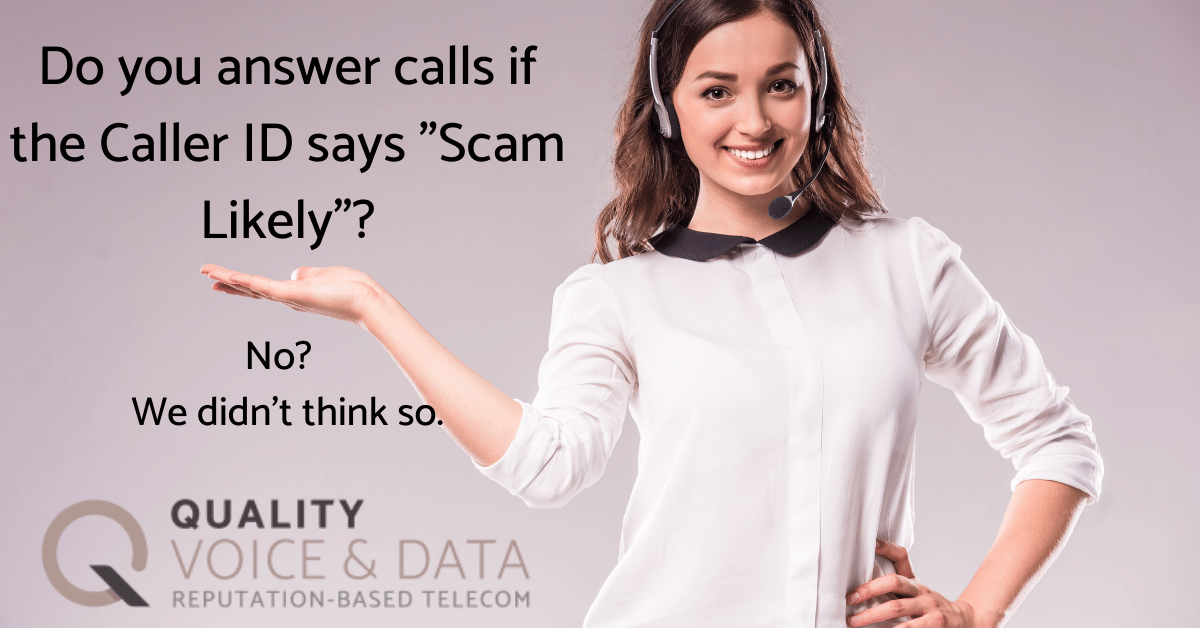Do you answer the call if the caller ID says “Scam Likely?”
When robocalls spiked in 2021, the “Scam Likely” notice appeared more often on people’s phones. This change may have been due to new FCC STIR/SHAKEN regs that carriers had to comply with by June 30 of that year.
As technology advances, telecom engineers that support outbound call teams must become savvier to ensure legitimate calls go through. In addition to unknown calls that cellphone users decline, telecom carriers are actively blocking and labeling calls that are not transmitted with a SHAKEN A Attestation.
How many blocked calls do you face per day? 1,000? 10,000? Is that number growing? There is a tug-of-war between the scammers and legitimate callers, and the stakes increase as technological tools improve.
How robocallers and scammers are getting more sophisticated
With VOIP and VPN technology, coupled with algorithms, machine learning, and lightning-fast connection speeds through the network, robocallers and scammers are getting more sophisticated as they work around the “Scam Likely” messaging.
Unfortunately, these tools are getting cheaper as more competitors emerge. VOIP can cost as little as $99 a month per extension. VPNs cost around $10 a month. Then, all the scammers have to do is set their tools to run automatedly and let the spam calls begin.
Spammers and scammers employ call-spoofing tactics where the number appears as if it’s from a legitimate source. STIR/SHAKEN’s implementation which was completed on June 30th will prevent this.
There were 50 billion robocalls in America in 2021. And Americans now answer less than half of the calls they receive.
How call recipients combat robocallers and scammers
The traditional “block caller” method is particularly effective when recipients want direct control over blocking calls. U.S. consumers do not typically answer calls that display a “scam likely” notice on the incoming call and then block them. If they want to do further research, they put the number in Google, and “Who Calls Me” might show up rather than a legitimate company number. Android and Apple phones have proprietary tools that automatically block calls based on recipients’ parameters.
Another solution, albeit a bit more drastic, is for cellphone users to change phone numbers altogether. Carriers do this free of charge for a limited number of times per billing cycle. However, individuals cannot select their new number or whether it’s been used before. Even if someone gets a brand-new number that’s never been assigned, spammers will use it eventually. It’s a mathematical certainty.
The good news is that STIR/SHAKEN has been fully implemented and call recipients should be seeing a significant drop in robocallers and scam calls.

How the telecom ecosystem has evolved
Call attestation is the primary method that drives how STIR/SHAKEN works. It assigns a value to a phone number’s legitimacy. Each wireless carrier has relationships with companies that provide data that inform a blocking and labeling decision on a call-by-call basis. When an individual receives a call from a phone number with a negative reputation or not signed by the originating telecom carrier, the call will be labeled as “Scam Likely.”
Carriers use sophisticated reasonable call analytics that measures and monitors network traffic based on phone numbers and how often they call. This process creates trust with the carriers, but it still has problems. Anything abnormal is flagged. Most carriers use this as an opt-in technology, but it’s not perfect, and neither is call attestation.
Developing trust can also come from a call with a checkmark verified by the carrier. Again, this technology isn’t perfect. Some numbers that are legitimate wind up on telecom blocklists. Some numbers that are a scam can have a verified number.
Enabling brand trust with caller IDs is one way to handle the “Scam Likely” message. Businesses can work with telecom providers and other software companies to make their business name and logo appear next to an incoming call, making it clear who the call is from. Yes, callers may not recognize the company and may still block the call. But this method gives businesses a fighting chance to get through.
Another way to develop trust is for companies to publish the numbers they call from. Most customer service departments at large companies have toll-free numbers to call. But individual and specialized departments, like billing, compliance, or accounts receivable, may have different numbers. Publishing these numbers outright will give those “Scam Likely” messages a better context.
Call labeling is another promising technology. Rather than identify the company that’s calling, call labeling assigns a category to the call, like “marketing”, “nonprofit”, or “political” to the incoming call. This already happens on a general level with “Scam Likely,” but further labeling can help maintain your caller ID reputation.
QVD is an authorized SHAKEN service provider
Quality Voice & Data provides Trusted Call Completion for call centers, outbound teleservices (sales) organizations, and other legitimate companies that need to contact existing customers or prospects.
As a SHAKEN Service Provider, we can sign your calls with an A Attestation with carriers to ensure they are appropriately labeled.
Protect your caller ID reputation and earn back a measure of brand trust with a STIR/SHAKEN provider with the experience, relationships, and industry knowledge to help your business succeed. Click here to set up a meeting with Steve Eveland, our VP of Sales:
Angela Garfinkel, Director at Quality Voice and Data, brings over 30 years of experience in call center and business process outsourcing. Well known in the telemarketing and telecommunications industry, she co-authored a course for The Direct Marketing Association and actively participates in professional groups like PACE. Her educational background includes an MBA and an undergraduate degree in Telecommunications Management from the University of Nebraska.
